NASA’s Artemis 1 mission continues to be a source of wonder for observers here on Earth.
Orion is currently headed home after successfully executing an engine burn on Monday (Dec. 5) while just 79 miles (128 kilometers) above the lunar surface, producing some truly spectacular images in the process. NASA mission managers have stated that Orion has been performing “phenomenally” throughout its maiden voyage that will end on Sunday (Dec. 11) when the spacecraft splashes down in a U.S. Navy training range off the coast of California.
On Dec. 3, while Orion was departing its distant retrograde orbit around the moon, the spacecraft was broadcasting its data signal back to ground stations on Earth with the help of NASA’s Deep Space Network. One amateur visual and radio astronomer, Scott Tilley (opens in new tab), was able to acquire and record Orion’s data signal during this period, which when sonified (turned into audible sound), truly sounds out of this world.
Related: Artemis 1 Orion spacecraft on track for return to Earth after moon flyby
Live updates: NASA’s Artemis 1 moon mission
The recording of the Artemis 1 data signal that Tilley released on Twitter (opens in new tab) was of one of the signal’s harmonics — parts of the transmission’s frequency wave that are whole number multiples of the signal’s fundamental, or primary, frequency.
This particular harmonic is what Tilley calls the “Lower 45,” as it can be found 45.45454545 kilohertz below the signal’s nominal frequency. In an email to Space.com about the recording, Tilley wrote that these harmonics can be useful for helping to track Orion using the Doppler effect, a change in a wave’s frequency caused by changes in an observer’s position relative to the signal source. In this case, the Doppler effect is caused both by Earth’s movement around the sun and Orion’s trajectory through space.

“Artemis1 sends a data signal that repeats every 528 microseconds,” Tilley told Space.com. “Repeating elements of the signal’s contents cause it to create strong signal elements that appear as weak repeating carriers. The frequency behavior of the carriers are being used to study the trajectory of the mission via the Doppler effect.”
RELATED STORIES:
Orion broadcasts its signal toward Earth, where it is received by three dishes that make up NASA’s Deep Space Network: One in Madrid, Spain; one in Canberra, Australia; and one at the Goldstone Deep Space Communication Complex near Barstow, California. Amateur observers like Tilley, who contributes to the satellite-tracking blog Riddles in the Sky, (opens in new tab) can also tune in throughout the mission — if they have the right equipment. It’s worth noting, however, that Orion’s data stream is encrypted. While anyone can tune in to it for tracking purposes, it is impossible to glean any data from it.
While the technical aspects of tracking Orion by its data signal will be lost on most of us, anyone fascinated by the groundbreaking journey of NASA’s Artemis 1 mission can enjoy the mesmerizing sound of the Orion spacecraft as it phones home.
Follow Brett on Twitter at @bretttingley (opens in new tab). Follow us on Twitter @Spacedotcom (opens in new tab) or on Facebook (opens in new tab).


